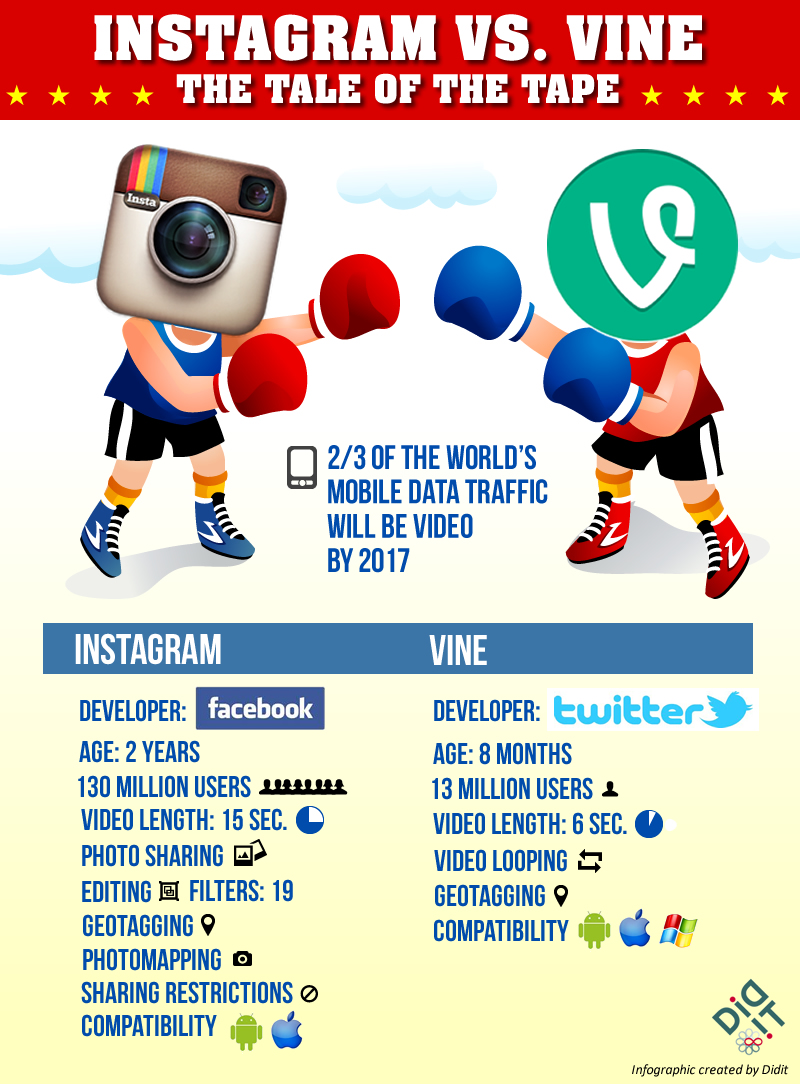 August 8, 2013: Instagram now allows users to upload 15-second streaming videos. In light of Instagram’s recent acquisition by Facebook, we see this new functionality as a direct challenge to Vine, which is run by Twitter. Both platforms are extensions of the Facebook and Twitter services, respectively.Both platforms provide a variety of different features for the recording and playback of smart phone video. So far, Instagram seems to have some strengths that Vine does not.We polled our own staff to see which platform is preferred by these professional marketers. 82% of Didit Staff prefers Instagram over Vine, for the following reasons:
August 8, 2013: Instagram now allows users to upload 15-second streaming videos. In light of Instagram’s recent acquisition by Facebook, we see this new functionality as a direct challenge to Vine, which is run by Twitter. Both platforms are extensions of the Facebook and Twitter services, respectively.Both platforms provide a variety of different features for the recording and playback of smart phone video. So far, Instagram seems to have some strengths that Vine does not.We polled our own staff to see which platform is preferred by these professional marketers. 82% of Didit Staff prefers Instagram over Vine, for the following reasons:
- Instagram has longer video length, provides video editing features, plus several other features that make it a more fun platform for our staff.
- Instagram is available on many more platforms than Vine.
- Instagram is shareable to many more platforms – Facebook, Twitter, the Web, and more.
- Instagram has many filters and other onboard editing tools, and is usable from your phone. Vine lacks the filters and tools, and isn’t usable on a mobile device.
However, Vine also has certain advantages. Here are a few:
- Vine videos can loop.
- Vine videos have no sharing restrictions. Vine provides for native embed code, whereas Instagram is more of a ‘walled off’ experience. This is a huge competitive advantage for Vine.
- Vine is an extension of Twitter and makes full use of Twitter features (hashtags, retweeting, analytics)
- Vine has first mover advantage and (arguably) greater brand recognition.
In terms of analytics, Instagram doesn’t include them, but usage can be tracked using platforms such as Simply Measured and Staticgram. Vine has its own simple native analytics, and can also be measured with Simply Measured. Both platforms support hashtags.According to Kaitlynn Russo at Contenthub, having coverage on both of these video platforms is advantageous at this time, due to the fact that use of video increases conversions irrespective of platform. We feel that no matter what platform you choose, you should have a video content strategy. There is plenty of advice for how to use Instagram and Vine for campaigns, but we advise that you first carefully examine both platforms to match your product and overall plans before diving into the details.
So, why does video matter to me?
It only matters if it’s part of a solution to fulfill your marketing goals. You as a marketer should look at the devices that your target audience uses, what type of video content will reach your audience, and what will be the most efficient use of your resources. Instead of just taking our word for it, we advise that you establish a baseline of performance on both platforms,test, and adjust your approach and campaigns based on what performs best for you. Simple A/B tests can give you clarity as to what platform makes the most sense for you and your audience.
For a quick recap of Instagram Versus Vine features, see our own infographic below:

- 10 Mistakes to Avoid When Using QR Codes for Marketing - September 20, 2023
- Kevin Lee on How AI Changes the SEO Landscape - August 31, 2023
- The Power of Compound Marketing: Kevin Lee Presents @ 1MediaWorld 2023 Global Conference - March 7, 2023
